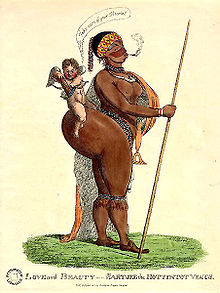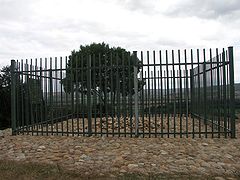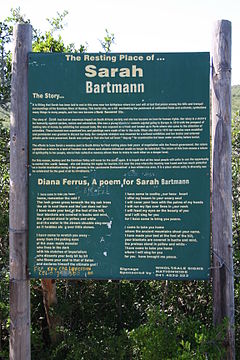- Sarah Baartman
-
For the South African patrol vessel, see Sarah Baartman (ship).
Sarah Baartman 
A caricature of Baartman drawn in the early 19th centuryBorn Before 1790[1]
Near Gamtoos River, Eastern Cape, Dutch EmpireDied December 29, 1815
Paris, FranceResting place Vergaderingskop, Hankey, Eastern Cape, South Africa
33°50′14″S 24°53′05″E / 33.8372°S 24.8848°ECoordinates: 33°50′14″S 24°53′05″E / 33.8372°S 24.8848°EOther names Hottentot Venus Ethnicity Khoikhoi Occupation "freak show" performer Sarah "Saartjie" Baartman (before 1790 – 29 December 1815)[1] (also spelled Bartman, Bartmann, Baartmen) was the most famous of at least two Khoikhoi women who were exhibited as freak show attractions in 19th century Europe under the name Hottentot Venus—"Hottentot" as the then-current name for the Khoi people, now considered an offensive term,[2] and "Venus" in reference to the Roman goddess of love.
Contents
Southern Africa
Sarah Baartman was born to a Khoisan family in the vicinity of the Gamtoos River in what is now the Eastern Cape of South Africa.[2] She was orphaned in a commando raid. Saartjie, pronounced "Sahr-kee", is the diminutive form of her name; in Afrikaans the use of the diminutive form commonly indicates familiarity or endearment rather than a literally short stature. Her birth name is unknown.
Baartman was a slave[2][3][4] of Dutch farmers near Cape Town when Hendrick Cezar, the brother of her slave owner, suggested that she travel to England for exhibition, promising her that she would become wealthy. Lord Caledon, governor of the Cape, gave permission for the trip, but later regretted it after he fully learned its purpose. She left for London in 1810.
Great Britain
Baartman was exhibited around Britain, entertaining people by showing what were thought of as highly unusual bodily features. She had large buttocks (steatopygia) and the elongated labia of some Khoisan women. To quote historian of science Stephen Jay Gould, "The labia minora, or inner lips, of the ordinary female genitalia are greatly enlarged in Khoi-San women, and may hang down three or four inches below the vulva when women stand, thus giving the impression of a separate and enveloping curtain of skin".[5] Baartman never allowed this trait to be exhibited while she was alive,[6] and an account of her appearance in London in 1810 makes it clear that she was wearing a garment, although apparently a tight-fitting one.[7]
Her exhibition in London, scant years after the passing of the Slave Trade Act 1807, created a scandal. An abolitionist benevolent society called the African Association – the equivalent of a charity or pressure group – petitioned for her release. On November 24, 1810 at the Court of King's Bench the Attorney-general began the attempt 'to give her liberty to say whether she was exhibited by her own consent'. In support he produced two affidavits in court. The first, from a Mr Bullock of Liverpool Museum, was intended to show Baartman had been brought to Britain by persons who referred to her as if she were property. The second, by the Secretary of the African Association, described the degrading conditions under which she was exhibited and also gave evidence of coercion.[7] Baartman was questioned before a court in Dutch, in which she was fluent, and stated that she was not under restraint and understood perfectly that she was guaranteed half of the profits. The conditions under which she made these statements are suspect, because it directly contradicts accounts of her exhibitions made by Zachary Macaulay of the African Institution and other eyewitnesses.[6] On December 1, 1811 Baartman was christened at Manchester Cathedral.[8][9]
France
Baartman was sold to a Frenchman, who took her to his country.[10] An animal trainer, Regu, exhibited her under more pressured conditions for fifteen months. French naturalists, among them Georges Cuvier, head keeper of the menagerie at the Muséum national d'Histoire naturelle, visited her. She was the subject of several scientific paintings at the Jardin du Roi, where she was examined in March 1815: as Saint-Hilaire [11] and Frédéric Cuvier, a younger brother of Georges, reported, "she was obliging enough to undress and to allow herself to be painted in the nude." Once her novelty had worn thin with Parisians, she began to drink heavily and support herself with prostitution.[2]
Death and legacy
She died on 29 December 1815 of an indetermined[12] inflammatory ailment, possibly smallpox,[13] while other sources suggest she contracted syphilis,[2] or pneumonia. An autopsy was conducted, and published by French anatomist Henri Marie Ducrotay de Blainville in 1816 and republished by French naturalist Georges Cuvier in the Memoires du Museum d'Histoire Naturelle in 1817. Cuvier notes in his monograph that Baartman was an intelligent woman who had an excellent memory and spoke Dutch fluently. Her skeleton, preserved genitals and brain were placed on display in Paris' Musée de l'Homme[14] until 1974, when they were removed from public view and stored out of sight; a molded casting was still shown[15] for the following two years.
 Last resting place of Saartjie Baartman, on a hill overlooking the town of Hankey in the Gamtoos River Valley
Last resting place of Saartjie Baartman, on a hill overlooking the town of Hankey in the Gamtoos River Valley
There were sporadic calls for the return of her remains, beginning in the 1940s, but the case became prominent only after Stephen Jay Gould wrote The Hottentot Venus in the 1980s. After the victory of the African National Congress in the South African general election, 1994, President Nelson Mandela formally requested that France return the remains. After much legal wrangling and debates in the French National Assembly, France acceded to the request on 6 March 2002. Her remains were repatriated to her homeland, the Gamtoos Valley, on 6 May 2002[10] and they were buried on 9 August 2002 on Vergaderingskop, a hill in the town of Hankey over 200 years after her birth.[16]
Baartman became an icon in South Africa as representative of many aspects of the nation's history. The Saartjie Baartman Centre for Women and Children,[17] a refuge for survivors of domestic violence, opened in Cape Town in 1999. South Africa's first offshore environmental protection vessel, the Sarah Baartman, is also named after her.[18]
Cultural references
- On January 10, 1811 at the New Theatre, London, a pantomime called 'The Hottentot Venus' featured at the end of the evening's entertainment.[19]
- In his 1847 novel Vanity Fair, William Makepeace Thackeray referred to the Hottentot Venus, explaining George's aversion to marrying a woman of color.
- Dame Edith Sitwell referred to her allusively in "Hornpipe", a poem in the satirical collection "Façade".[20]
- Poet Elizabeth Alexander explores her story in a 1987 poem and 1990 book, both entitled The Venus Hottentot.
- Diana Ferrus, a South African poet of Khoisan descent, wrote "A Poem for Sarah Baartman" while studying in Europe. It includes the desire "to wrench [her] away-/ away from the poking eyes... ."
- Poet M. K. Asante wrote "Ghetto Booty: The Hottentot Remix" for Saartjie Baartman in his 2005 book Beautiful. And Ugly Too. The poem tells Baartman's story and warns the hip hop generation not to repeat racist cycles of black female exploitation.
- The science fiction author Paul Di Filippo used her story as the basis for the second novel of his Steampunk Trilogy.
- Barbara Chase-Riboud wrote a fictional biography entitled Hottentot Venus.
- Her life features in the 2007 Afrikaans romantic novel Frats by Chris Karsten.
- Playwright Suzan-Lori Parks fictionalizes her story in Venus.
- Playwright Lydia R. Diamond's play "Voyeurs de Venus" also examines her story through the eyes of a 20th-century author.
- In 2006, a feminist artist and filmmaker adopted the name Venus Hottentot to direct an independent film with erotic content called Afrodite Superstar with the intention of reclaiming the strength and voice of Sarah Baartman as a sexually-exploited woman of color.
- Canadian performance artist Mara Verna created a web-based project and travelling exhibition cataloguing her story.[21]
- Novelist Joyce Carol Oates uses the image and the story of the Hottentot Venus in her 2006 novel Black Girl/White Girl.
- The Saartjie Project is a collection of artists and activists using theatrical productions including song, dance, visual arts, spoken word and drama to explore the continued fascination with the black female form; to create dialogue; and to promote healing across communities.[22]
- A movie entitled Black Venus, directed by Abdellatif Kechiche and starring Yahima Torres as Sarah, was released in 2010.
- Composer Hendrik Hofmeyr composed a 20 minute opera entitled Saartjie which will be premiered by Cape Town Opera in November 2010.
See also
Bibliography
- Sara Baartman and the Hottentot Venus: a ghost story and a biography. Princeton University Press. 2009. ISBN 0691135800.
- Holmes, Rachel (2006). The Hottentot Venus. Bloomsbury, Random House. ISBN 0-7475-7776-5.
Footnotes
- ^ a b Sara Baartman and the Hottentot Venus: a ghost story and a biography. Princeton University Press. 2009. pp. 184. ISBN 9780691135809.
- ^ a b c d e Lucille Davie (12 August 2002). "Sarah Baartman, at rest at last". SouthAfrica.info. http://www.southafrica.info/ess_info/sa_glance/history/saartjie.htm.
- ^ Venus abused | Salon Books
- ^ Sara Story
- ^ Gould, 1985
- ^ a b (Strother 1999)
- ^ a b The Times, November 26, 1810, p. 3: "...she is dressed in a colour as nearly resembling her skin as possible. The dress is contrived to exhibit the entire frame of her body, and the spectators are even invited to examine the peculiarities of her form."
- ^ The Times, Thursday 12 December 1811, p.3:'The African fair one who has so greatly attracted the notice of the town...is stated to have been baptized on Sunday week last, in the Collegiate church at Manchester, by the name of Sarah Bartmann.'
- ^ England Births and Christenings 1538-1975, Sarah Bartmann http://www.familysearch.org
- ^ a b "'Hottentot Venus' goes home". BBC. 29 April 2002. http://news.bbc.co.uk/2/low/europe/1957240.stm. Retrieved 13 October 2008.
- ^ possibly Étienne Geoffroy Saint-Hilaire
- ^ The Journal of Science and the Arts III (V): p. 154. 1818. http://www.archive.org/stream/journalsciencea02britgoog#page/n187/mode/1up/search/venus. Retrieved 19 July 2010.
- ^ In The Blood by Steve Jones has it that "Saartje's hands are covered by the marks of the smallpox that killed her" (p. 204).
- ^ Hal Morgan and Kerry Tucker. Rumor! Fairfield, Pennsylvania: Penguin Books, 1984, p. 29.
- ^ Untrodden fields of anthropology : observations on the esoteric manners and customs of semi-civilized peoples. American Anthropoligical society. http://www.archive.org/stream/cu31924029859174#page/n459/mode/1up/search/venus. Retrieved 19 July 2010.
- ^ Kerseboom, Simone. ""Burying Sara Baartman": Commemoration, Memory and Historica Ethics.1". Stellenbosch University History Department. http://academic.sun.ac.za/history/news/s_kerseboom.pdf. Retrieved 23 October 2008.
- ^ The Saartjie Baartman Centre for Woman and Children
- ^ "SA takes on poachers". 11 November 2005. Archived from the original on 30 September 2007. http://web.archive.org/web/20070930211009/http://www.news24.com/News24/Technology/News/0,,2-13-1443_1645283,00.html.
- ^ The Times, January 10, 1811; p. 2
- ^ Walton: 'Hornpipe' from Facade
- ^ Hottentot Venus
- ^ The Saartjie Project
References
- Crais, Clifton and Pamela Scully (2008). Sara Baartman and the Hottentot Venus: A Ghost Story and a Biography. Princeton, Princeton University Press. ISBN 978-0-691-13580-9
- Fausto- Sterling, Anne (1995). "Gender, Race, and Nation: The Comparative Anatomy of 'Hottentot' Women in Europe, 1815–1817". In Terry, Jennifer and Jacqueline Urla (Ed.) "Deviant Bodies: Critical Perspectives on Difference in Science and Popular Culture", 19-48. Bloomington, Indiana University Press. ISBN 0-253-32898-5.
- Gilman, Sander L. (1985). "Black Bodies, White Bodies: Toward an Iconography of Female Sexuality in Late Nineteenth-Century Art, Medicine, and Literature". In Gates, Henry (Ed.) Race, Writing and Difference 223-261. Chicago, University of Chicago Press.
- Gould, Stephen Jay (1985). "The Hottentot Venus". In The Flamingo's Smile, 291-305. New York, W.W. Norton and Company. ISBN 0-393-30375-6.
- Ritter, Sabine: Facetten der Sarah Baartman: Repräsentationen und Rekonstruktionen der ‚Hottentottenvenus‘. Münster etc.: Lit 2010. ISBN 3643109504.
- Strother, Z.S. (1999). "Display of the Body Hottentot", in Lindfors, B., (ed.), Africans on Stage: Studies in Ethnological Show Business. Bloomington, Indiana, Indiana University Press: 1-55.
- Qureshi, Sadiah (2004), 'Displaying Sara Baartman, the 'Hottentot Venus', History of Science 42:233-257. PDF available here.
- Willis, Deborah (Ed.) "Black Venus 2010: They Called Her 'Hottentot' ISBN 978-1-4399-0205-9. Philadelphia, PA. Temple University Press
External links
Categories:- 1779 births
- 1815 deaths
- Art and cultural repatriation
- Khoikhoi
- People from the Eastern Cape
- Sideshow performers
- South African slaves
Wikimedia Foundation. 2010.

